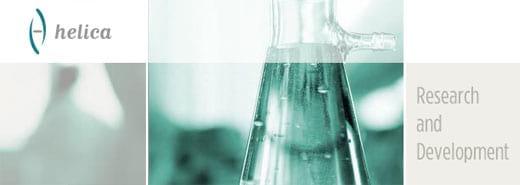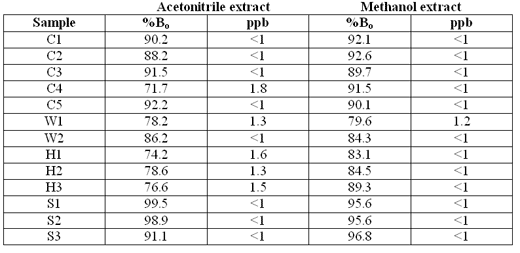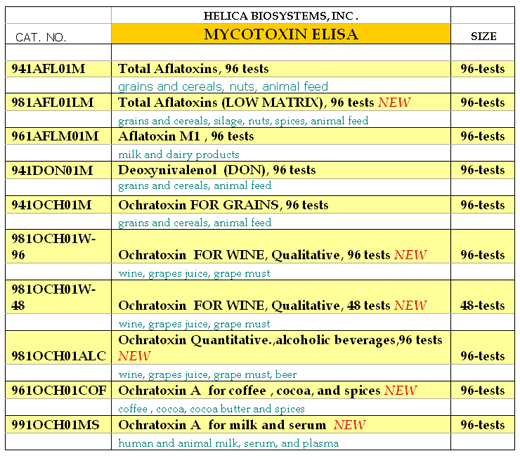Introducing Low Matrix ELISA for Aflatoxin and Ochratoxin A detection in difficult-to-assay commodities

Helica Biosystems, Inc is pleased to announce an innovative approach to testing aflatoxins and ochratoxin A in commodities which pose difficult problems in measurement by conventional "rapid" ELISA methods.
The so-called rapid ELISA method provides for a quicker and simpler assay with less manipulation by the operator and is used where speed and simplicity are at a premium, for instance when large truckloads of grain must be screened for mycotoxin content.
The main drawback with this type of assay is the well known 'matrix effect'. These problems are compounded by the fact that a mycotoxin assay may be used with many different kinds of commodity extract, and controlling for matrix effect in one commodity by, for instance, using an antigen-free extract in the assay would only correct for the effects of that particular matrix and would likely be incorrect for others. A case in point is the assay of aflatoxin in silage, a vegetable matter usually a byproduct of grain harvests preserved by fermentation in a large enclosed structure or silo and is an important component of cattle fodder. Immunoassay of aflatoxin in silage extract in a conventional rapid assay leads to high false positive values in samples that contain no aflatoxin by the HPLC gold standard.
A similar situation exists in the case of ochratoxin A. While most grains and cereals, with a relatively moderate matrix effect, may be screened for ochratoxin content using the simultaneous incubation of sample and conjugate, commodities such as coffee, cocoa, spices, and grape derivatives such as red wine are notoriously difficult to test due to "matrix effect".
As a solution to this problem, Helica Biosystems, Inc has successfully devised immunoassays to measure total aflatoxins and ochratoxin in silage, coffee and other high matrix effect commodities at biologically useful levels. These low matrix assays are now available for distribution world-wide (see test list in Appendix). We are pleased to present the following set of data from a study we conducted to validate the field utility of this method.
PART 1 - LOW MATRIX ELISA FOR AFLATOXINS
Studies comparing Low Matrix ELISA with the HPLC gold standard
Extraction study
Thirteen samples of finely ground silage: five corn silage (C1 - C5), two wheat silage (W1 - W2), three hay silage (H1 - H3) and three snaplage (S1 - S3) samples which had previously measured negative for aflatoxins B1, B2, G1 and G2 at the 1 ppb level by HPLC following solid-phase clean up of the extracted samples.** These samples were extracted by vigorous vortexing in either 80% methanol or 80% acectonitrile at a 1:5 ratio of commodity to solvent for two minutes and measured in the Helica Biosystems low matrix total aflatoxin ELISA (Cat. no. 981AFL01LM). Results are presented below.
Recovery Study
Each of the different types of silage was also spiked with 5 ng/gm (5ppb) of aflatoxin B1 and dried down overnight at room temperature in order to estimate the recovery of aflatoxin by the two different solvents. The following results were obtained:
The following extraction and recovery experiments were also performed on store-bought samples of paprika, pistachio and peanuts which are commodities also prone to contamination by aflatoxin
Extraction Study
Recovery Study
Conclusion
While 70-80% methanol is frequently used in the extraction of commodities for the assay of aflatoxins by ELISA, it can clearly be seen from these results that acetonitrile extraction is more efficient than methanol, giving efficiencies of 85-100% in all cases except peanuts which was 67%. If methanol is used for extraction its extraction efficiency of 50-70% should be taken into account.
It is difficult to determine at this point whether the low (<2ppb) values measured in some silage samples represents residual matrix effect or the cumulative measurement of several aflatoxin types (B1,B2,G1,G2) present at less than 1 ppb levels. Otherwise the Helica Biosystems low matrix ELISA is a cost effective screening tool for total aflatoxin content in a wide variety of commodities destined for animal or human consumption.
** We would like to acknowledge Trilogy Analytical Laboratory (Washington, MO, USA) for kindly performing the HPLC analysis in this study.
PART 2 – LOW MATRIX ELISA FOR OCHRATOXIN A
Ochratoxin A in Wine and Beer
Ochratoxin-free samples of grape products and beer were spiked with ochratoxin in levels from 0.4 to 8.0 ng/mL in wine and 0.04 to 0.8 ng/mL in the case of beer. After aa simple 1:20 dilution in methanol (1:2 in beer), they were assayed for ochratoxin A with the Helica Biosystems quantitative assay for ochratoxin in alcoholic beverages (Cat. no. 981OCH01ALC). Recoveries of ochratoxin A from the various commodities compared ot the kit standards are given below:

The results demonstrate that the Helica Biosystems Quantitative Ochratoxin A assay can be used to measure Ochratoxin A in a wide variety of alcoholic and non-alcoholic beverages.
Please see product package insert for more detailed data (below).
Ochratoxin A in Coffee, Cocoa, and Spices
Samples were spiked with 5 ug/Kg (ppb) of ochratoxin A and dried overnight. They were then extracted in 80% acetonitrile in a 5:1 ratio (solvent:commodity). Acetonitrile was shown to be superior to methanol for this purpose. After a 10-fold dilution in 70% methanol, the extracts were measured in the Helica Biosystems Quantitative assay for ochratoxin in coffee, cocoa, and spices (Cat. no. 961OCH01COF). Extraction and recovery experiments were performed three times for each commodity with the following results:
Please see product package insert for more detailed data (below).
Ochratoxin A in Serum and Milk
As a result of the report “Assessment of Dietary Intake of Ochratoxin A by the Population of EU Members States: Report fo Experts Participating in Task 3.2.7, Jan 2002”, it is apparent that a simple procedure for the accurate measurement of ochratoxin A in serum and milk would be of great benefit in assessing the bioburden of this mycotoxin in human populations.
Human and animal serum and milk were spiked with 0.2 ng/mL of cohratoxin A. After a 4-fold dilution in methanol were assayed in the Helica Biosystems Quantitative assay for ochratoxin in milk and serum (Cat no. 991OCH01MS). Recoveries were repeated three times and compared to recovery from a similarly spiked phosphate buffered saline solution. Results are presented below.

Please see product package insert for more detailed data (below).
This assay should provide a useful adjunct to the measurement of ochratoxin A in individual commodities destined for human and animal consumption.
Please contact us for additional information on these and other assays. Package inserts are available by request. A complete list of our MycoMonitor® line of ELISA assays follows in the appendix.
APPENDIX









